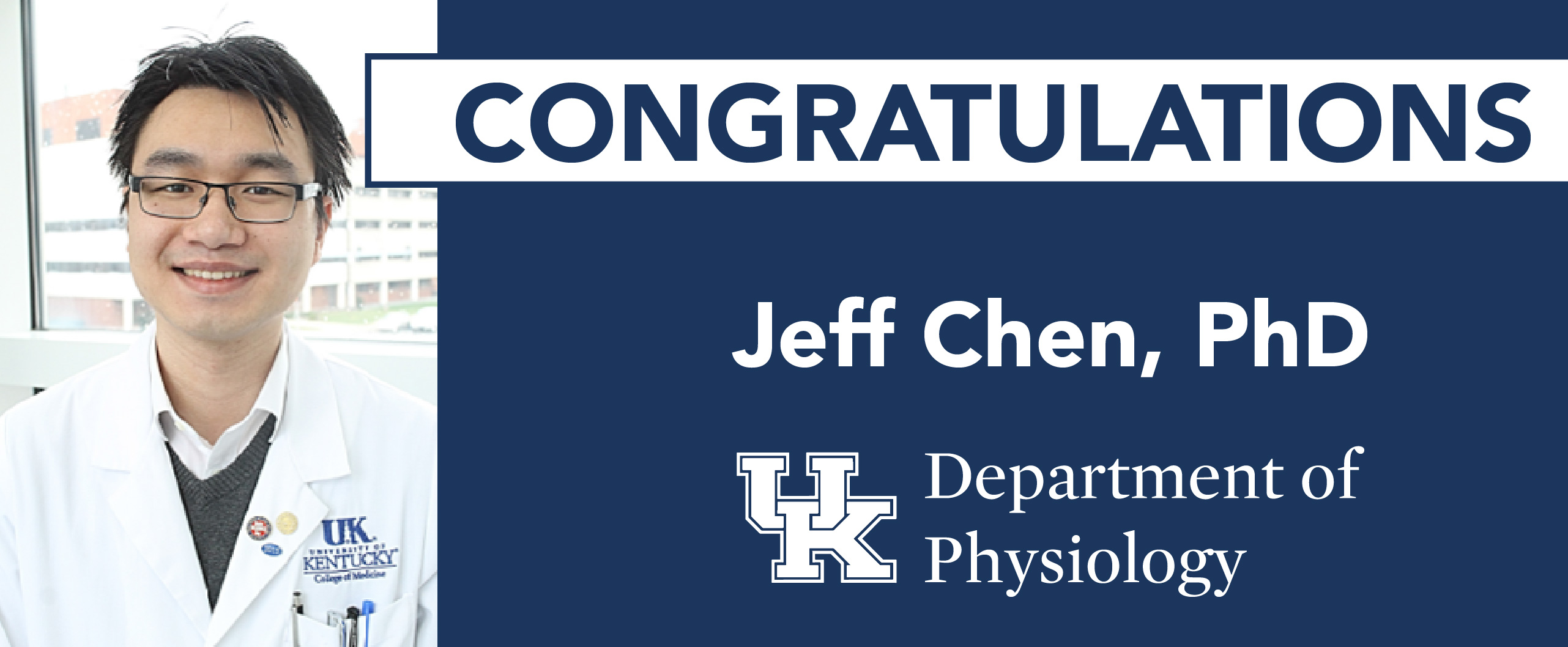Congratulations Jeff Chen, PhD
On Monday, June 15, 2020 Jeff Chen successfully defended his dissertation and earned his PhD.
"Involvement of the Renin Angiotensin System in Marfan Syndrome Associated Thoracic Aortic Aneurysms"
Doctoral Committee
Dr. Alan Daughety
Department of Physiology, Mentor
Dr. Ken Campbell
Department of Physiology
Dr. Ming Gong
Department of Physiology
Dr. Nancy Webb
Department of Pharmacology & Nutritional Sciences
Outside Examiner, Dr. Vincent Venditto
Department of Pharmaceutical Sciences
Abstract
Thoracic aortic aneurysms (TAAs) are clinically-silent dilations of the aorta which greatly increase the risk of aortic rupture, a condition with 50-90% mortality. Marfan syndrome (MFS) is caused by mutations in fibrillin-1 (FBN1) and is associated with TAAs. Due to an absence of validated and effective pharmacologic therapies to prevent or reverse TAA, most MFS patients require surgical aortic repair. Understanding MFS associated TAA pathogenesis would direct development of new pharmacologic therapies. Previous research has implicated the renin angiotensin system in TAA. In both males and females, angiotensinogen (AGT) is cleaved serially to generate the main effector peptide angiotensin II (AngII). AngII is the main ligand of AngII receptor type 1a (AT1aR). However, the role of angiotensin II (AngII) receptor type 1a (AT1aR) in MFS associated TAA formation is unclear. Here, we test the hypothesis that AngII-dependent AT1aR stimulation is responsible for Marfan syndrome associated TAA. To study the contribution of the renin angiotensin system on MFS associated TAA, we used the fibrillin-1 haploinsufficient (Fbn1C1041G/+) and fibrillin-1 hypomorphic (Fbn1mgR/mgR) mouse models. TAA in MFS mice demonstrated sexual dimorphism. Compared to male Fbn1C1041G/+ mice, female Fbn1C1041G/+ mice exhibited less ascending aortic dilation. To study AT1aR in MFS associated TAA, we bred male and female AT1aR deleted (AT1aR / ) x Fbn1C1041G/+ mice. We measured the ascending aorta up to 12 months of age by high frequency ultrasound sequentially. We evaluated aortic medial structure at study termination. Compared to male AT1aR+/+ x Fbn1C1041G/+ mice, male AT1aR / x Fbn1C1041G/+ mice exhibited less ascending aortic dilation and reduced elastin fragmentation. Ascending aortic dilation was not significant between female AT1aR / x Fbn1C1041G/+ mice and female AT1aR+/+ x Fbn1C1041G/+ mice. To study the contribution of angiotensin peptides, we administered angiotensinogen antisense oligonucleotides (AGT ASO) to male Fbn1C1041G/+ mice. Compared to male Fbn1C1041G/+ mice administered control ASO, mice administered AGT ASO exhibited less ascending aortic dilation and reduced elastin fragmentation. TAA in the mouse models of MFS is sexually dimorphic. Inhibition of the renin angiotensin system via either AT1aR deletion or AGT ASO is sufficient to attenuate ascending aortic dilation in male Fbn1C1041G/+ mice. However, the effect of AT1aR deletion was not detectable in female Fbn1C1041G/+ mice. Depletion of angiotensin ligands was efficacious in attenuating MFS associated TAA in male Fbn1C1041G/+ mice. However, factors that impact TAA of other etiologies have minimal impact on MFS associated TAA. These studies indicate that modulating the renin angiotensin system is highly effective to attenuate MFS associated TAA in males.
Acknowledgements
This work was supported by my advisors, colleagues, friends, and family at the University of Kentucky and beyond. It was done in hopes that the knowledge and ideas described here can - one day - be leveraged to improve the lives of people and their families living with Marfan syndrome. Thank you, my advisor – Dr. Alan Daugherty – for his mentorship, support, and patience; for teaching me not only how to do good science but also how to be a good scientist; for giving a lifetime worth of lessons over the last four years. Thank you, my PhD advisory committee members – Drs. Kenneth Campbell, Ming Gong, Nancy Webb – who encouraged, and challenged, me to reach past my potential; especially when I needed it. Thank you, Dr. Mary Sheppard, who guided me in both the lab and clinic – constantly reminding me of the higher purpose for this work – and is the physicianscientist I one day hope to be. Thank you, members of the Daugherty Lab past and present. Drs. Hong Lu and Hisashi Sawada, who entertained my ideas and shared both victories and setbacks. Deborah Howatt, Jessica Moorleghen, Debra Rateri, and Micheal Franklin, whose expertise and support enabled it all. Colleagues in the Department of Physiology, Saha Cardiovascular Research Center, and the UK-BCM Aortic Research Center. Countless members who briefly overlapped but left lasting impressions. Thank you, Therese Stearns, for her friendship through the years and the University of Kentucky MDPhD program for giving me the chance to prove myself. This work was enabled through the support of the National Institutes of Health and American Heart Association as well as through Dr. Susan Smyth and the University of Kentucky Center for Clinical and Translational Science. Thank you to my family, who grew roots in this country so that they could tirelessly support me, even if they may not understand all the details of what I do. Finally, thank you Dr. Eileen Hu. From the time we met, almost a decade ago, you have been my best friend, partner in crime, cheerleader, critic, and rival. You inspire me to be my best. Without you, I would not be where I am today. I can’t wait to see where we go from here.
